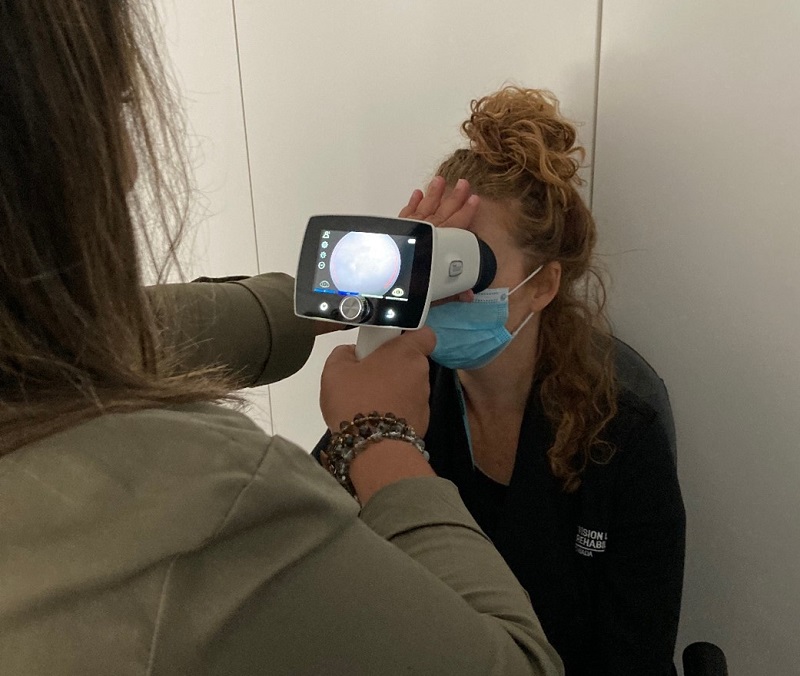Concentrated Programs
Filling gaps in community health care services
Working with provincial governments and other key partners, we're proud to provide a range of Concentrated Programs designed to fill gaps in care for some communities across Canada – and reduce the overall burden on the health care system.
Unlike our other services, these programs are available only in some regions (determined based on community needs and funding), and are delivered in a course-style structure in fixed increments.
Currently, we deliver the following concentrated programs in select regions across Canada:
- Aging in Place Program
- Stroke Program
- Falls Prevention Program
Aging in Place Program
Our Aging in Place Program is an integrated model of care specifically for seniors who have vision loss as well as other additional chronic conditions. The program provides a connected care solution from hospital discharge to community reintegration, which not only greatly benefits the client, but benefits hospitals by reducing emergency room visits, hospital admissions, and lengths of stays.
The Aging in Place program provides clients with:
- Increased access to health care in their homes with a focus on how vision loss impacts care outcomes
- Connections to appropriate resources allowing for seamless coordination of services that best meets the individual’s needs
- Smart home technology and a medication adherence system to increase safety and independence in the home and reduce medication errors
Stroke Program
Our Stroke Program is designed to provide comprehensive, in-home rehabilitation services for individuals experiencing vision impairments after a stroke. The key objectives of this program include:
- Providing comprehensive vision assessments for clients
- Reducing clients' time spent in hospital and supporting them with the transition from hospital to home
- Preventing negative long-term effects by providing appropriate intervention to promote safety, participation in daily activities, independence, mobility, physical functioning, and psychosocial health
- Enhancing quality of life and reducing readmission rates for clients
- Reducing rates of caregiver burnout and stress
- Advocating for screening, early detection, and treatment of eye disease and/or vision loss
Falls Prevention Program
Our Falls Prevention Program is designed specifically for older adults with vision loss who are at risk of falling. The program aims to improve knowledge and education on fall risk, home and community safety; increase independence within the home; and reduce falls (as well as the fear of falls) for this population. The key objectives of this program include:
- Identifying falls risk among older adults with vision loss
- Providing vision-related falls and safety education for organizations and older adults with vision loss
- Promoting safety in the home, when performing activities of daily living, and with community navigation
- Increasing exercise and physical activity for clients
- Decreasing fear of falls among older adults with vision loss and increasing their confidence to age at home safely
Rapid Response Program
Urgent support when it's needed most.
The Vision Loss Rapid Response Program (VLRRP) is a short-term, maximum four-week program designed to address the needs of clients whose functional vision loss jeopardizes their ability to return home, progress in their recovery, or benefit from an existing inpatient rehabilitation program.
It provides an end-to-end model of care for individuals diagnosed with vision loss in an innovative integrated approach between the acute sector and community services. This integrated collaborative approach will ensure a high-quality patient-centred service, leading to better outcomes for these individuals.
The program assists two types of clients:
- People with a medical condition who have recently experienced visual changes and deficits related to their hospitalization.
- People with a pre-existing visual impairment which is impacting their recovery and ability to return to their home in the community, regardless of the reason for hospitalization.
The program addresses the most critical and time-sensitive issues affecting those with vision loss while in the hospital or rehabilitation to ensure they have gained the skills necessary to be safe and independent for basic self-care and mobility in their home and community.
Eye Health Screening Initiative
All people with Diabetes who are over 12 years old should receive regular eye screenings. Diabetic Retinopathy is one of the leading causes of vision loss in Canada and is the most frequent cause of new cases of blindness among adults younger than 75. Research has shown that early detection, timely treatment, and appropriate follow-up care can reduce the risk of vision loss by 95 per cent.
Vision Loss Rehabilitation Canada (VLRC) has developed the Eye Health Screening Initiative (EHSI) in partnership with community organizations to provide screenings for diabetic retinopathy. The EHSI brings screenings closer to home and is integrated into existing programs and services for underserved, rural, remote, and Indigenous individuals.
How it works
The EHSI aims to reduce the risk of vision loss through the early detection and treatment of diabetic retinopathy. The program uses portable hand-held fundus cameras and Health Canada approved artificial intelligence (AI) software to screen individuals in under 15 minutes. Digital photos are taken of both retinas and uploaded into the AI software which can detect retinopathy with 98 per cent sensitivity and 97 per cent specificity. The report is developed within 60 seconds and shared along with educational resources at point of care. For clients who receive a positive screening result, VLRC has a dedicated Care Coordinator who will coordinate the required follow-up care with the client’s primary care provider and/or appropriate eye care professional.
If your organization would like to join us in reducing vision loss caused by diabetic retinopathy, we encourage all prospective partners to contact Caitlin Lazarus, National Director, Eye Health Screening initiative at Caitlin.Lazarus@vlrehab.ca

